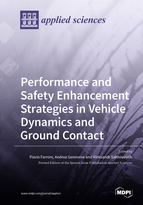Performance and Safety Enhancement Strategies in Vehicle Dynamics and Ground Contact
A special issue of Applied Sciences (ISSN 2076-3417). This special issue belongs to the section "Mechanical Engineering".
Deadline for manuscript submissions: closed (30 September 2021) | Viewed by 56092
Special Issue Editors
Interests: vehicle dynamics; vehicle performance optimization; multiphysical modeling of tire/road interaction; friction and viscoelasticity of polymers; outdoor testing; onboard safety and performance enhancement logics; human/machine interface; driving simulations
Interests: vehicle dynamics; applied science and mechanics; tribology; dynamic systems; smart system; energy harvesting; design and development of mechatronic systems and vibration control
Interests: vehicle dynamics; applied science and mechanics; tribology; multiphysical modeling of nonlinear systems; virtual sensors and estimators; autonomous driving; dynamic systems and control
Special Issue Information
Dear Colleagues,
We have the pleasure to invite you to contribute to the Special Issue dedicated to “Performance and Safety Enhancement Strategies in Vehicle Dynamics and Ground Contact”. Recent trends in vehicle engineering prove the great effort that scientists and industries have made in seeking solutions to enhance both the performance and the safety of vehicular systems. Physical models concerning vehicle/ground interaction, control strategies for the vehicle and its subsystems, and new technologies are developing all over the world for this purpose. This Special Issue aims to contribute to the study of modern vehicle dynamics, attracting recent experimental and in-simulation advances that are the basis for the current technological growth and for future mobility. The area involves research, studies, and projects coming both from vehicle dynamics and contact mechanics, with the perspective to embrace activities aiming to enhance vehicle performance in terms of handling, comfort, and adherence, and to examine safety optimization also in the emerging contexts of smart, connected, and autonomous driving.
This Special Issue will focus on, but not be limited to, new results in the following topics related to vehicle dynamics and ground interaction:
- Physical models concerning tire/road, wheel/rail, and generic vehicle/ground interaction;
- Experimental activities aimed at the investigation and the comprehension of interaction phenomena, from the macroscale, analyzing the whole vehicle data, to the microscale, accounting for indentation, friction, and contact mechanics at the ground;
- Control strategies focused on vehicle performance enhancement, in terms of handling/grip, comfort and safety, for passenger, motorsport, and future mobility scenarios;
- Innovative technologies to improve the safety and performance of the vehicle and its subsystems;
- Identification of vehicle and tire/wheel model parameters and state with innovative methodologies and algorithms;
- Implementation of real-time software, logic, and models in onboard architectures and driving simulators;
- Studies and analysis oriented toward the correlation among the factors affecting vehicle performance and safety, with the target to propose strategies for their optimization;
- Application use cases in road and off-road vehicles, e-bikes, motorcycles, buses, trucks, etc.
Dr. Flavio Farroni
Dr. Andrea Genovese
Dr. Aleksandr Sakhnevych
Guest Editors
Manuscript Submission Information
Manuscripts should be submitted online at www.mdpi.com by registering and logging in to this website. Once you are registered, click here to go to the submission form. Manuscripts can be submitted until the deadline. All submissions that pass pre-check are peer-reviewed. Accepted papers will be published continuously in the journal (as soon as accepted) and will be listed together on the special issue website. Research articles, review articles as well as short communications are invited. For planned papers, a title and short abstract (about 100 words) can be sent to the Editorial Office for announcement on this website.
Submitted manuscripts should not have been published previously, nor be under consideration for publication elsewhere (except conference proceedings papers). All manuscripts are thoroughly refereed through a single-blind peer-review process. A guide for authors and other relevant information for submission of manuscripts is available on the Instructions for Authors page. Applied Sciences is an international peer-reviewed open access semimonthly journal published by MDPI.
Please visit the Instructions for Authors page before submitting a manuscript. The Article Processing Charge (APC) for publication in this open access journal is 2400 CHF (Swiss Francs). Submitted papers should be well formatted and use good English. Authors may use MDPI's English editing service prior to publication or during author revisions.
Keywords
- Vehicle dynamics
- Contact mechanics
- Tire analysis and modeling
- Friction and viscoelasticity Indoor and outdoor testing
- Control strategies
- Active safety
- Future mobility systems
- Grip and vehicle setup optimization
- Driving simulators
- Physical modeling
- Vehicle state estimation








